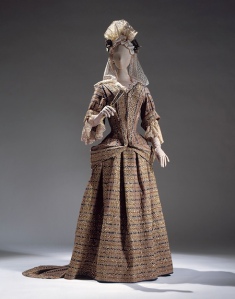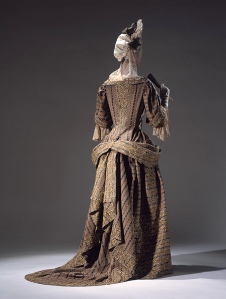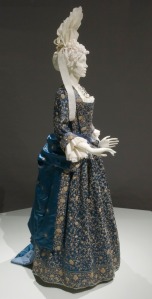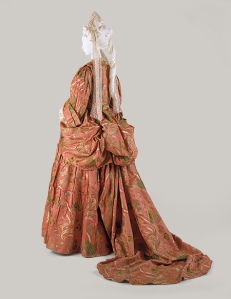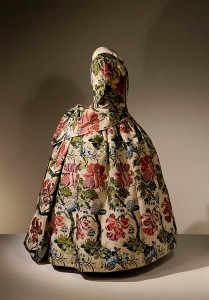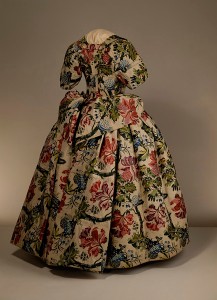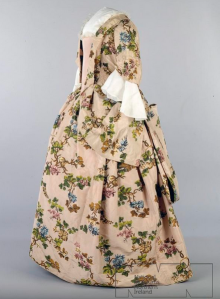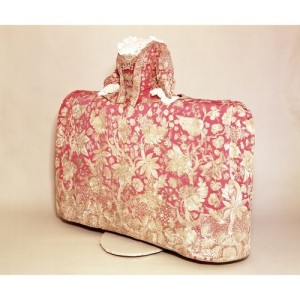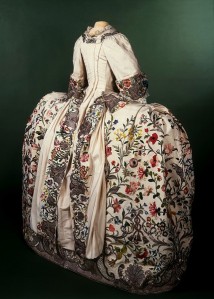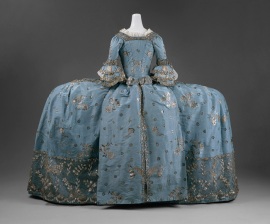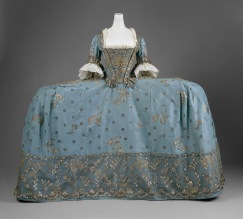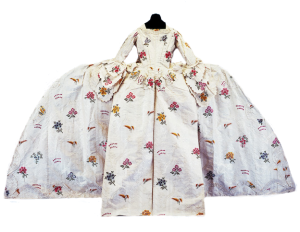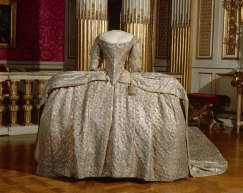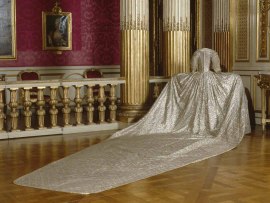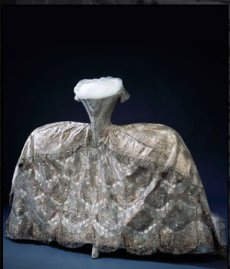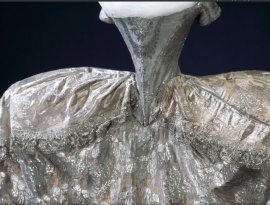The most challenging garment to transfer to a paper pattern was the gown. While researching and looking at existing example of garments both first hand in museums such as the V&A, London, and the National museum of Scotland, Edinburgh, at online museum collections e.g. The Metropolitan Museum of Art, New York, which hold a vast assortment of 18th century costume and within reference books I could not find anything that resembles Elisabeth’s gown or many of the other portraits I have looked at. In the portrait her gown appears not to have any seams or joins at the front. This was my first problem as almost every example of a gown I had scene from the 18th century was closed or fastened at the front. My first thought was the dress could have been a Robe à l’Anglaise, these usually closed at the centre front and though it may have been possible that the embroidery was hiding the close, however with further research I concluded the l’anglaise style was not right. Its sleeves are fitted, its neckline slightly square and its bodice plainly decorated. The Robe à l’Anglaise was a development of the Robe à la Française or sacque back gown as it is also known, the main distinctive feature of this gown being the large pleats that hang from the centre back, the development to the Robe à l’Anglaise being that these pleats were stitched down onto the bodice rather than let loose to drape. These are also sometimes named Watteau pleats after the artist Antoine Watteau due to his fascination with painting the dress style. The Robe à la Française was usually worn with a stomacher and had fitted sleeves sometimes flounced cuffs unlike Elisabeth’s dress. Another factor to consider is the dates do not fit. We can judge my her age and style that Elisabeth’s portrait was painted at the beginning of the 18th century whereas the fashions of robes la Française and à l’Anglaise were popular between the 50’s to 80’s.
Countess de Mailly 1698
Met museum late 17th century
I then decided to look further back into history and find out about the styles at the end of the 1600’s in the hope that that would lead me to an answer. I found that the leading style from the 1680’s into the 1700’s was a robe called the Mantua. Elisabeth was alive 1668 to1738 meaning the Mantua was the prominent style for the majority of her adult life. Its first form was a coat-like robe with cuffed elbow length sleeves worn over boned stays with straps and a back lace fastening. Skirt of the robe was open and drawn back over the hips to reveal the gathered petticoats worn underneath. By the 1690’s the top of the mantua was opened and the decorative stomacher panel was introduced
LACMA 1700’s
Met museum 1708
. The style was so popular at this point that dressmakers became known as mantua-makers. The mantua adapted to the changing skirt shapes and was adjusted to be worn over panniers, its draped skirt progressively got smaller until it was only a hanging pleated flap that was swept back over the hips of the panniers.
1709 duchess of burgundy 1730-40
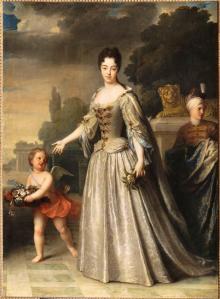
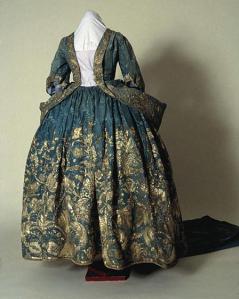
1735-40
1740’s
1740-45
1744
1748-50
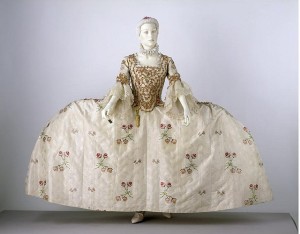
1750
Court-Mantua-Kensington-Palace 1750-1760
1772 Sophia Magdalena of Sweden coronation
Elizabeth Charlotte Holstein-Gottorp wedding dress 1774
The sleeve style of large cuffs and the decorative stomacher of the Mantua matched that of Elisabeth’s garb however there was still the problem of the almost off the shoulder neck line. The majority of portraits I have looked at from the first half of the 18th century all have this feature although none of the existing examples do. Another thing I noticed about early 1700’s portraits is the extreme sloping of the shoulders, after looking in to the history of art at this time I discovered that the elongated slanting and exposure of the shoulders was considered the pinnacle of beauty and femininity at this time. Therefore the gowns stylised appearance when painted was not necessarily what I would have actually looked like in the flesh. This solved my problem of finding a pattern for my dress.

